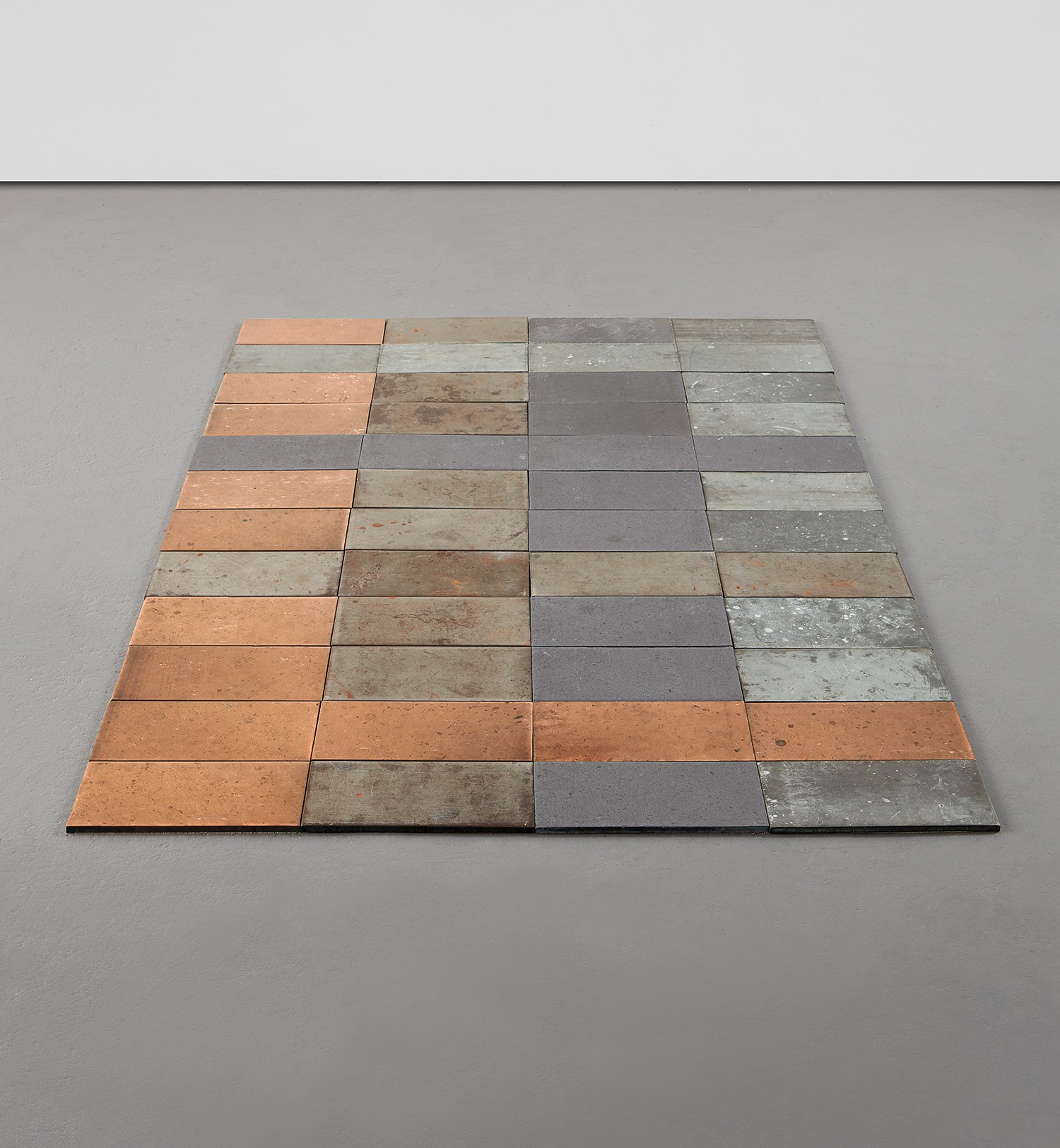

Property from a Private Collection, New York
23
Carl Andre
48 Bar Rectangular Fugue on 4 Ancient Metals
copper, steel, lead and zinc, in 48 parts
each 1 x 15 x 30 cm (3/8 x 5 7/8 x 11 3/4 in.)
overall 1 x 180 x 120 cm (3/8 x 70 7/8 x 47 1/4 in.)
overall 1 x 180 x 120 cm (3/8 x 70 7/8 x 47 1/4 in.)
Executed in 1988, this work is accompanied by a statement of authenticity signed by the artist.
Full-Cataloguing
Reflecting Carl Andre’s unwavering engagement with minimalist principles, and demonstrating the artist’s use of real space as a medium, 48 Bar Rectangular Fugue on 4 Ancient Metals, 1988, deploys a set of 48 copper, zinc, lead, and steel tiles in a neat rectangular formation of 12 x 4. The work plays to varying degrees with physicality in direct response to perspective shifts, thus transforming into a different geometric entity with each new step taken by the viewer. As remarked by Andre, ‘what the idea of “minimal art” means to me is that the person has drained and rid himself of the burden, the cultural over-burden that stands shadowing and eclipsing art. I think you have to really rid yourself of those securities and certainties and assumptions and get down to something, which is closer and resembles some kind of blankness. Then one must construct again out of this reduced circumstance’ (Carl Andre, quoted in Alistair Rider, Carl Andre: Things in Their Elements, London 2011, p. 249). Building from core elements and ‘some kind of blankness’, the artist departs from perceived conventions of minimal art and instead enters the realm of nature itself through pure reduction – an endeavour he continuously worked towards throughout his career.
Extending further in length than in width, 48 Bar Rectangular Fugue on 4 Ancient Metals bears a loose – yet potent – association to Andre’s pathworks, which are closer in appearance to elongated lines than they are to pervasive ‘metal rugs’. These rectangular plates additionally act as distinct organisms that profoundly alter the phenomenological nature of their environment. They form part of a subgroup to Andre's series of metal floor plates, whereby the artist did not restrict his creative method to the use of hot-rolled steel but instead made use of additional industrial materials such as copper, zinc, and lead. This omnifarious combination of elements in turn affected the coloration of the plates over time, yielding a myriad of surface variations. Each tile presents a different type of reflection, firmly matte on the surface or glowing like embers, thus echoing Andre’s ambition to creates works that are ‘in [a] constant state of change. I'm not interested in reaching an ideal state with my works. As people walk on them, as the steel rusts, as the brick crumbles, as the materials weather, the work becomes its own record of everything that's happened to it’ (Carl Andre, quoted in David Bourdon, ‘A Redefinition of Sculpture,’ Carl Andre: Sculpture 1959-1977, New York, 1978, p. 32).
Extending further in length than in width, 48 Bar Rectangular Fugue on 4 Ancient Metals bears a loose – yet potent – association to Andre’s pathworks, which are closer in appearance to elongated lines than they are to pervasive ‘metal rugs’. These rectangular plates additionally act as distinct organisms that profoundly alter the phenomenological nature of their environment. They form part of a subgroup to Andre's series of metal floor plates, whereby the artist did not restrict his creative method to the use of hot-rolled steel but instead made use of additional industrial materials such as copper, zinc, and lead. This omnifarious combination of elements in turn affected the coloration of the plates over time, yielding a myriad of surface variations. Each tile presents a different type of reflection, firmly matte on the surface or glowing like embers, thus echoing Andre’s ambition to creates works that are ‘in [a] constant state of change. I'm not interested in reaching an ideal state with my works. As people walk on them, as the steel rusts, as the brick crumbles, as the materials weather, the work becomes its own record of everything that's happened to it’ (Carl Andre, quoted in David Bourdon, ‘A Redefinition of Sculpture,’ Carl Andre: Sculpture 1959-1977, New York, 1978, p. 32).